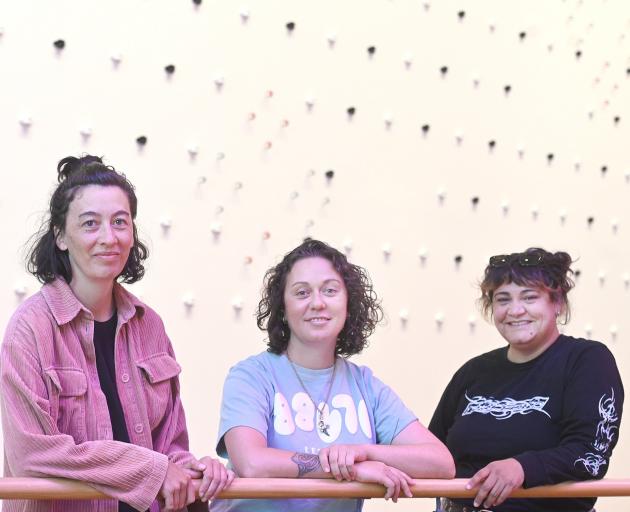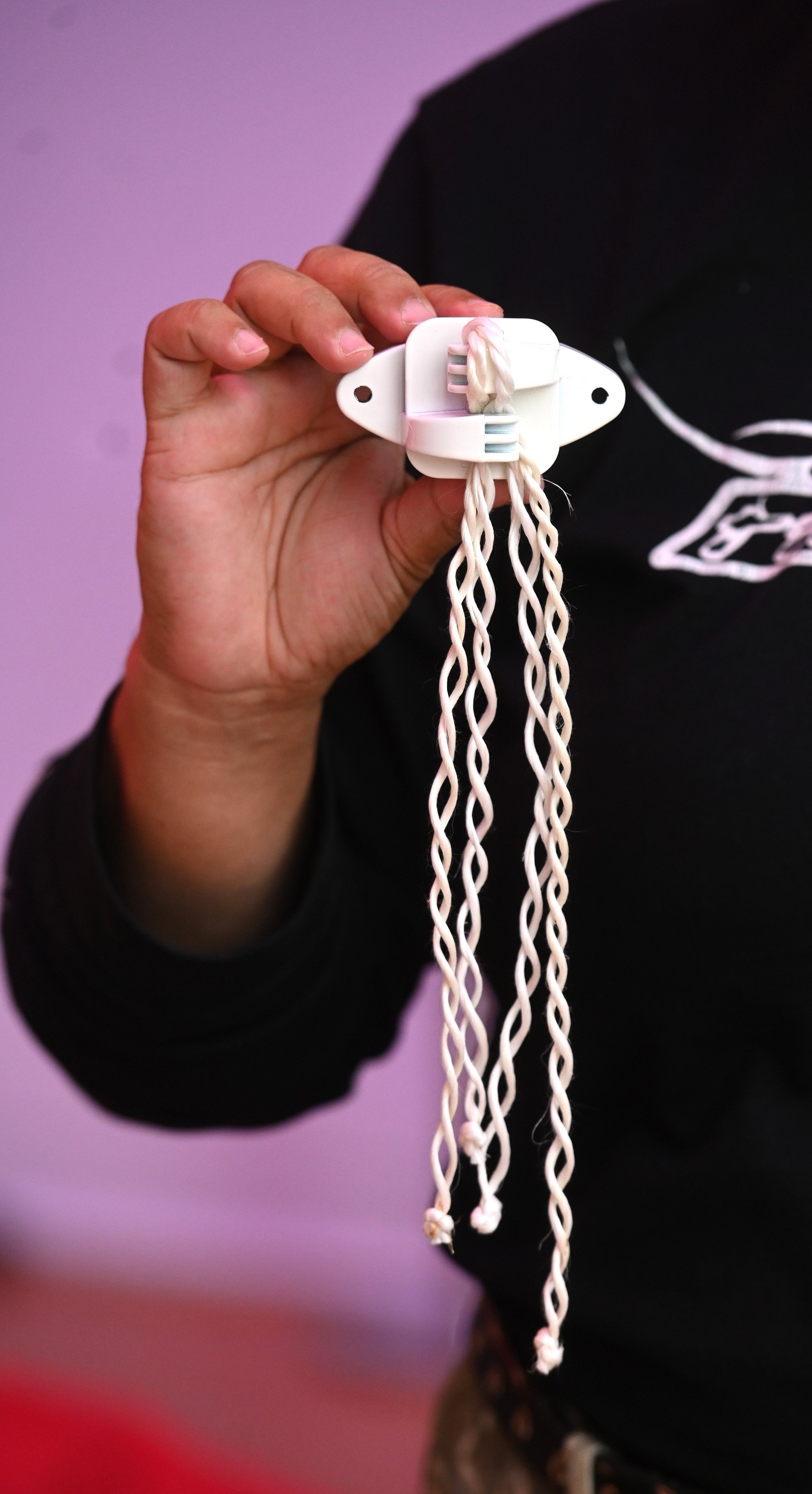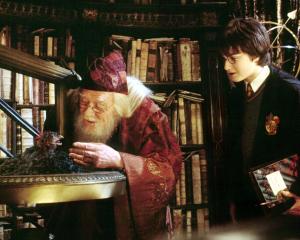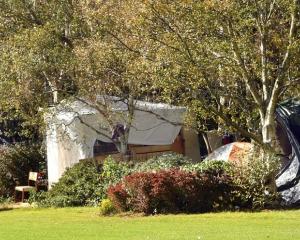
After their success at the Venice Biennale, the Mataaho Collective is revelling in a summer at home and spending time in Dunedin creating their latest project, Hautāmiro.
The artists talk to Rebecca Fox about the joy of working with natural materials again.
Sitting in the sun weaving wool over fence staples, members of the Mataaho Collective are quietly enjoying the feel of the natural material as it feeds through their fingers.
Seemingly oblivious to the bangs as the staples, once covered in wool, are hammered into the Big Wall at Dunedin Public Art Gallery, three of the group’s four artists collected around a table work together harmoniously.
They have given themselves a fortnight to put together Hautāmiro, a new large-scale work inspired by the visual language of hukahuka (tassels or fringing) whakarākei and the adornments of customary kākahu (cloaks), and are enjoying every minute of their first New Zealand residency since they came together as a collective in 2012.
Being offered the Dunedin Public Art Gallery Aotearoa Visiting Artist programme residency has been special for the group, who last year won the Golden Lion at the Venice Biennale in Italy for their work Takapau, a large-scale installation using polyester reflective truck strops inspired by whāriki techniques and patterns.
It meant the group - comprising Whakatāne artist and co-founder of Kauae Raro Research Collective Sarah Hudson (Ngāti Awa, Ngāi Tūhoe, Ngāti Pūkeko); Dunedin-based artist, curator and editor of ATE Journal of Māori Art Bridget Reweti (Ngāti Ranginui, Ngāi Te Rangi); and Manawatū-based artists Erena Arapere-Baker (Te Atiawa ki Whakarongotai, Ngāti Toa Rangātira), who is a lecturer in Māori visual art (Toioho ki Āpiti) at Massey University, and Dr Terri Te Tau (Rangitāne ki Wairarapa), who is also a science fiction writer - knew when they returned to New Zealand they had the summer at home to work on the project.
‘‘It’s really grounding just to be ticking away and busy but in a way that's really fulfilling,’’ the collective says.
They began by thinking about some of the many ideas they are always mulling over, thinking about materials or techniques they had not used before but wanted to.
‘‘They kind of come up each time we approach a new project.’’
This time, knowing they would be in New Zealand gave them the perfect opportunity to work with natural materials.
‘‘So that's a big reason why we went with the harakeke [New Zealand flax] aspect of the work,’’ the collective says.

‘‘We really love the eye-catching adornments on these garments. They've always kind of astounded us, the designs and the colours and the use of wool.
‘‘So we've wanted to work with muka, [the inner fibre of flax] taking design elements from this customary clothing and doing it on a large scale. We've wanted to do that for years. We're really excited to do it.’’
They realised it was a great opportunity to undertake some new material practice, as often in doing their research they learn, but often do not get to practically handle natural materials or use customary technique.
‘‘So just learning some new processes [to make things] that we've really loved seeing. And finding some skills and spending some time doing things like extracting muka to make kārure [cord] and pōkinikini [flax tags],’’ the collective says.
‘‘So to spend time with the materials and the techniques at home is really special.’’
It also meant each of them, when spending time in their own communities, could speak to weavers about the best types of harakeke bush to use.
‘‘It’s meant we can extend our practice into our communities at home as well.
‘‘It will definitely feed our practice for years to come. Being able to really get those skills on lockdown.’’
Wool is also used to acknowledge how, as soon as it was introduced to Aotearoa, it became incorporated into garments very quickly. The colours being used in the work reflect a common combination in some early kākahu that had the embellishments.
‘‘These kinds of embellishments, which were maybe influenced by the embroidery that young Māori women were being taught at the time - more like little tufts or pom-poms - was something that we had really wanted to incorporate into work for a long time, many years. We experimented with trying to make them with muka and things like that. That didn't really work out. But it was fun to think of how we ended up where we are.’’
That led to the discovery that wool was often sourced from fences where it had got caught.
‘‘It was like foraging or harvesting. It was a precious material.’’
Muka also used to be hung over fences to dry in Southland. So they looked more closely at fences, picking up on the staples and insulators that held the number 8 wire to fences. Some of the staples are being covered with wool using an embroidery-like stitch used on cloaks; another technique is being used to cover others, giving a fluffier effect that represents a ngore (pom pom) that is stitched on to cloaks.
‘‘With a lot of our work it's taking domestic-sized, bodily-sized techniques and upscaling them.’’
So being able to fill a space with those techniques and celebrate it is an important part of the project.
For the collective, fences mean boundaries, and reference the conversion of land to sheep farming and the dispossession from land Māori would have had free access to prior to European arrival, limiting their available resources.
‘‘So it's a championing of natural materials, this project, and we also recognise that the wool industry in Aotearoa is struggling where previously these industries have thrived. Yeah, just thinking local, like where do we get our materials from? How do we use them? How can we start using them again?
‘‘So, to do a work at home, using materials from home, has been important.’’

All up, the staples have required 5000 holes to be drilled in the wall, and they have used 2000m of wool and 1000 tags to create the work.
Some of the adornments on traditional kākahu are embellishments which move with the wearer and the wind, bringing them to life.
‘‘There's a lot of gracefulness that can come with wearing these garments.’’
So they have created four different types of adornments, each of them acknowledging one of the ancestral narratives of Tokohurunuku, Tokohururangi, Tokohurumawake and Tokohuruatea, the four winds, or the pillars of the sky.
‘‘It wasn't that easy to come across some information about that narrative, so it's quite nice to highlight. Another atua wahine that's not so talked about or not discussed in kind of common narrative.’’
Huruteaarangi, an atua of the winds, has four children and in the narrative where Ranginui (sky father) and Papatūānuku (earth mother) separated, she placed these four children as pillars to hold the space between the two.
‘‘What's kind of neat about them is they were wind, so they're not like big strong pou, but they're something that's more ethereal that is filling that space.’’
They have harvested the flax, processed and dried it in a process that utilises the natural curl of harakeke. The kārure is made from muka and is used to decorate cloaks. These elements become animated when worn on kākahu and are used in this project to relate to the movement of the wind, which is where the name for the exhibition comes from. ‘‘Hau’’ is the wind and ‘‘tāmiro’’ the twining or binding of threads.
The group likes to highlight atua wāhine in each of their works, even if it is not front and centre but in the research.
‘‘Sometimes it turns out that there isn't that much information written about a particular element, and that's when we have to kind of go on our lived experience, or we go outside or we work with materials, and keeping this kind of area of interest in mind, what's our experience of these atua.’’
The collective says they hope the work then sparks further research by others or insights that people might share with them or document.
In another first for the collective, which is known for its large installations, it is creating work on a large wall rather than a space or room. At Venice, their work was installed in the threshold to the curated exhibition.
‘‘It's been quite a nice change and a shift and a new way of thinking.’’
That led them to consider the wall as the kaupapa (foundation) of a cloak and then thinking through what that might or could look like.
‘‘So to think of a kākahu that's really big, expanded out, stretched out.
‘‘When I was talking to people over the summer, I said we're making a 20-metre long kākahu. We're not, but we are. And it's about the wind and I think those spaces in between.’’
For its overall design, the collective looked at examples of kākahu from around the country and internationally and analysed their visual language. They describe their design as a merger of a lot of them, but note it is not perhaps typical as it focuses on highlighting the four design elements.
For the collective, the ability to make art and highlight stories from the past is important.
‘‘Often those stories have only been seen or told through a very male perspective. We feel a responsibility to celebrate and represent a kind of wāhine Māori perspective on these pūrākau, on these narratives.
‘‘Because we get given these opportunities, we get quite a public platform to do these explorations. That definitely is a responsibility and we want to use these opportunities to share what we have found but kind of still push the boundaries and leave things open enough for other people to take what they can and bring their own experiences and perspectives to the work.’’
To see
Hautāmiro: Mataaho Collective
Dunedin Public Art Gallery,
February 22, 2025 to February 15, 2026.
Artist talk February 22, 11am.












